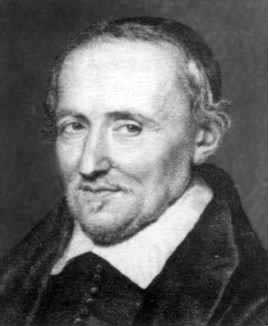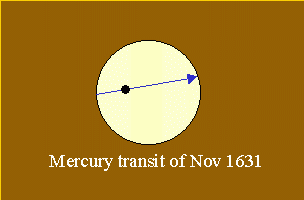![]()
P.
Gassendi and the Mercury transit of 1631
![]()
![]() Prediction
of the transit of 1631
Prediction
of the transit of 1631
![]()
P. Gassendi

Pierre Gassendi (1592 - 1655)
Pierre Gassendi was born in Champtercier (southeastern France), near the city of Digne on 22 January 1592 in a familly of peasants. He entered the college of Digne and the University of Aix-en-Provence (1609) to study philosophy and theology. He was ordained priest and appointed professor of Philosophy at Aix where he showed himself as a staunched opponent to the scholastic teaching and attempted a rehabilitation of the Epicurean doctrine.
He lived in Paris from 1628 to 1632 and travelled in England and Flanders and made lasting connections with Hobes and Father M. Mersenne before returning to Digne. He was in Paris to become the first person to record the transit of an innner planet on the Sun in 1631. Returning to Paris in 1641 he obtainted a professorship at the Collège Royal but has to resigned soon because of poor health. He remained essentially in Paris until his death on 24 October 1655.
Besides astronomy
his scientific interests were linked to the theory of vision and to the law
of inertia and free fall. He his said to have made an experiment in Marseille
to investigate the free fall of a body from the top a mast of a moving sailboat.
More on Gassendi :
http://www-groups.dcs.st-andrews.ac.uk/~history/Mathematicians/Gassendi.html
http://es.rice.edu/ES/humsoc/Galileo/Catalog/Files/gassendi.html
![]()
Prediction of the transit of 1631
After completion of
the famous Rudolphine Tables (tables describing in numbers the position of
the heavenly bodies deduced from the keplerian motion) J. Kepler issued a
small tract with the prediction that both Mercury and Venus will transit over
the Sun's disk In 1631 : on the 7 November for Mercury and on the 6 December
for Venus. He added that no other transit of Venus would occur before 1761.
Readers of these pages know probably that this was a mistake.
Modern calculation of the transit
| Date | Friday 7 November 1631 |
| Julian date | 2317080.807 |
| Solar radius | 969.8 arcsec |
| Mercury radius | 4.98 arcsec |
| Min. distance | 146.9 arcsec |
| Node | Ascending |
| Sunrise | 06:56 (local solar time) |
| At Paris |
|
|
|
| 1st contact |
|
||
| 2nd contact |
|
|
|
| 3rd contact |
|
|
|
| 4th contact |
|

![]()
Observations of P. Gassendi
Gassendi was the first, and one of the few(*), to witness the transit, at Paris. He admitted the light through a small opening in front of a dark room. The image of the Sun is then projected on a light screen and a circle is drawn to outline its overall shape. The diameter of the circle was just above 20 cm and was divided into 60 parts, so that one division was close to 30". An assistant in an adjacent room observed the altitude of the Sun with a quadrant to get an accurate timing of the events.
Because of the uncertainty in the predictions, Gassendi began to observed two days before the expected date. On the 5th the weather was poor, with rain all the day. The following day turned out to be quite as bad with the Sun hiddent behind the clouds. The 7th promised initially to be on the same
As soon as the Sun was
visible, a little before eight o'clock, Gassendi was able to see the Sun and
distinguish a small dark object, lie a sunspot. The Sun appeared again around
nine through the clouds, so that he could draw a second position and strengthened
his conviction that it was Mercury.
Then he could follow its progress on the surface of the Sun and draw the corresponding
chord on the screen. He immediately warned his assistant justt to discover
that he had left his post !
The planet was already well on the Sun when Gassendi first saw it. From its observed motion he calculated that the transit had started at 5h 28m A.M. and the egress occurred at 10h28m A.M, not very far from the modern computed value given in the above table. This was in advance by nearly five hours to the assigned time by Kepler :
"Le rusé Mercure voulait passer sans être apercu, il était entré plus tôt qu'on ne s'y attendait, mais il n'a pu s'échapper sans être découvert "
(*) For long it was thought that Gassendi was the only person to watch the transit. In fact there were at least three others to have seen the passage of Mercury in 1631 : Remus Quietanus at Rouffach (eastern France), Father Cysatus at Innsbruck, and an anonymous Jesuit at Ingolstadt.
![]()
Aftermath
This first observation
ever of the passage of a minor planet over the Sun was made known by Gassendi
in an account sent to W.
Shickardt, Professor of Mathematics at the University of Tuebingen. and
in " Mercuris is Sole visus, & Venus invisa" published in Paris
in 1631. Predictions from existing planetary tables improved gradually and
no observable transit after 1631 was missed. The next one was on the 9th November
1644, not visible in Europe. Then follows one on the 3rd May 1661, which was
observed in India. A full crossing was observable from Paris on the 7th November
1677. Each of these observations allowed to improve the theory of the motion
of the planet Mercury from the improvement of the node position and its rate
of precession.
© F. Mignard. Mise à jour mercredi 16/04/03